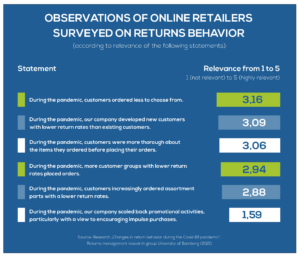Studienergebnisse
Borgholzhausen, January 20, 2021 – It is reported again and again: Corona is bringing enormous growth to many e-commerce players. In the fourth quarter of 2020 alone, e-commerce sales increased by more than ten percent compared to the same period last year. Do more orders also mean more returns? Not necessarily, as the study “Changes in return behavior during the Covid 19 pandemic” by the Returns Management research group at the University of Bamberg found out for the first six months of the pandemic.
More orders, more returns?
The Bamberg study can confirm this in absolute figures. Because projections show an increase of 4.6 percent with around 315 million returned packages in the period from March to August 2020. In relative terms, however, the return rate fell from 17.8 to 15.9 percent – despite the observation of more frequent multiple orders from different companies according to the motto “Whoever delivers masks, disinfectants and Co. first gets the job”. Retailers from the fashion and furnishing product clusters in particular are happy about more profitability thanks to high order numbers on the one hand and a low return rate on the other. While almost half of all clothing was returned in the same period last year, it was only just under 41 percent in the first months of the pandemic. Furnishings that were ordered were also allowed to stay in their own home more often: with a decrease of 1.92 percentage points.

Afraid of the Corona return?
According to the study, this development can be attributed in particular to the changed shopping behavior of German consumers. Products for everyday use were ordered significantly more than in the previous year, for which a lower return rate is generally to be expected – in the second quarter of 2020 this segment grew by over 50 percent. With the lockdown and the health insecurity associated with shopping for many, new customer groups were also developed who previously shopped more in brick-and-mortar retail and therefore showed less pronounced return behavior.

However, the lockdown and health risks have not only brought new customer groups and general sales growth to online retail. Apparently, these aspects also inhibited consumers from accepting returns. Because if you are not sure whether you can leave the post office without being infected or whether the parcel shop is actually allowed to be open, you want to minimize returns and thus the reasons for returns of your own accord.
Not only less, but also later
An additional trend that the study describes is the time of the return. This was often postponed and more retailers are reporting that customers are more likely to return at the end of the return period allowed. More customer time with the item allows for more testing and influences the decision to not return an item after all. However, if he decides to do so, more items with obvious signs of use were returned to the retailers or logistics service providers during the period under study. 24 percent of the retailers surveyed report an increase in such items. And the number of items that could only be recycled or even disposed of increased as a result.
In future surveys, the Returns Management research group would like to analyze whether these effects are temporary or even permanent trends. We are excited!

